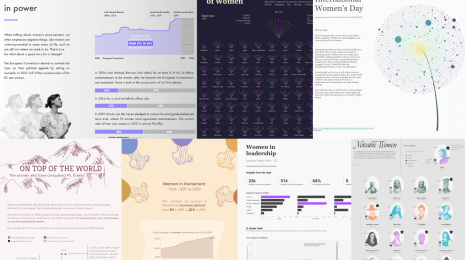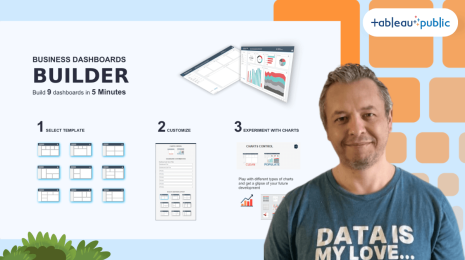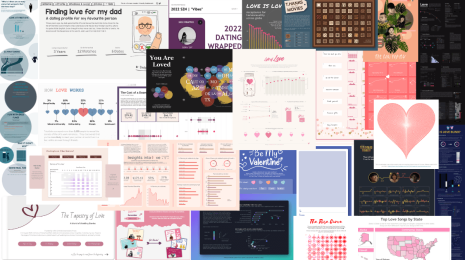From TCoT Berlin: How a major European airline keeps its competitive edge with Tableau

Lufthansa Group, including its subsidiaries, runs the largest airline fleet in Europe, flying tens of millions of people to more than 250 destinations worldwide.
Lufthansa Group generates terabytes of data every day around everything from route profitability and maintenance information to flight operations. With analyses in Tableau, the organization achieves the sweet spot between balanced costs and a world-class customer experience—creating a competitive differentiator in the competitive airline market.
At Tableau on Tour Berlin, Christian Novosel, Head of Corporate Development (Austrian Airlines) and Head of the Strategic Business Intelligence Initiative at Lufthansa Group joined James Eiloart, Tableau’s Senior Vice President of EMEA for the conference’s opening keynote to discuss how technology is transforming business initiatives.
Christian, tell us a bit about Lufthansa and give us a glimpse at what it takes to run an airline these days.
You probably all know the airline, but Lufthansa Group is more than that. We’re made up of seven airlines, and we handle everything from aircraft maintenance to catering globally in addition to flight operations. There’s also a ton of other business units, ranging from airline IT to insurance. And all this represents more than 30 billion EUR in revenue, about one million flights, and 110 million passengers annually.
However, running an airline is all about balancing cost with advancing more customized services for our customers. Tableau helps us better understand our customers at a very granular level and gives us the visibility needed to continuously optimize our cost base. With this level of analytical excellence, we can stay competitive in the market.
How does Lufthansa harness the minds of its employees? And what role does curiosity play?
Working at an airline is great because we generate terabytes of data every day. Just analyzing public global airline schedules is fun, but if you add in the volumes of data about aircraft movements, route profitability, or technical maintenance information, it’s an enormous playground. It can easily create a “data paralysis”, which we need to overcome.
In operations for instance, we’re analyzing the smartest way to train pilots on new aircraft types. We’re also analyzing things like crew vacation planning. Both of these things depend on a variety of variables. It gets really interesting, when combining data from different sources for overarching analysis. We can dig deeper into a certain question or hypothesis and identify causalities.
There’s an expert on every data source who knows all the details about his or her domain. But Tableau helps bring the right experts together and enables a large organization like Lufthansa to use all the expertise of its workforce to solve more complex questions.
Getting the right data minded, curious people on board and enabling them to have everything they need to live that curiosity is an essential part of the initiative I started. In large organizations, access to data is very restricted, so you need to create “islands” where all necessary prerequisites are met to foster analytical excellence.
You mentioned the critical impact that data and technology have on operations. Can you tell us about when the company decided to move to Tableau?
A few years ago, leadership asked my department to determine the profitability of our first class product. This sounds simple in theory, and you might be asking yourself why we didn’t know this already. In reality, we needed to determine how much fuel a certain “part” of the aircraft uses. 70% of our customers connect between different travel classes and galley space is shared across travel classes, so in practice, this is quite a complex question to answer.
Tableau was recommended to us and we bought the first Tableau Desktop License. With Tableau, we were not only able to solve this question, but we also created a beautiful dashboard that caught the attention of our leadership. Tableau enabled us to answer questions at the right moment, which pushed our organization to have an even more data-driven dialog.
Soon after, we connected to sales data, loyalty data, cost information, aircraft layouts (m² data), and more to come up with a model that can determine profitability for any given business segment. Tableau was the clear winner with the ability to combine different sources easily and create powerful, yet beautiful analysis.
As we are very cautious about data security and data protection, we do almost everything on-premise, and Tableau has the flexibility to supports that decision very well. Today, Lufthansa Group runs a Tableau Core Server solution, to be able to empower our entire workforce with the platform.
How does technology help drive innovation at Lufthansa?
Lufthansa has the great advantage of having a very good data infrastructure. However, as with any large company, it has grown into a complex environment of multiple warehouses holding different data domains. We are currently working to combine all those sources on a high-speed, in-memory data infrastructure.
Lufthansa had implemented a matrix organization, so experts for a certain topic, working for different group companies or airlines are functionally bundled. We are investing in collaborative infrastructure a lot, so we can work together in an easy and seamless process. Hence, I am looking forward to the collaborative capabilities on Tableau’s product roadmap.
What advice would you give other large companies looking to increase data collaboration at scale?
The larger a company gets, the more time and effort you need to spend on really understanding the complex cause-and-effect relationships needed to steer the business. I believe that it’s a pretty exponential relationship.
I also believe there are two components to success within large companies. First, create efficiency in analytics, which means standardize and automate a lot! Secondly, create room to dig deeper to understand the root behind an outlier, whether it’s a problem or a solution.
To become efficient, companies need to standardize most analyses. We’re currently working on what we call the “Digital Boardroom” where those standardized analyses are available to the decision makers. This will reduce ad-hoc requests and enable management to make decisions based on live data in meetings.
In an increasingly complex world, you want to take your time to actually understand causal relationships better. Identifying new rules of the game within your data, will be a unique selling proposition for any company. To achieve this, you need to “align the stars” and create those islands of curious people, data availability, technological support, and much more.
You cannot order or demand analytical excellence, but need to create a culture—and it’s essential to build communities in order to get there.
Looking to enable self-service analytics at scale with Tableau? Grab your ticket to Tableau Conference 2017 to learn from 300 breakout sessions, including presentations from more than 80 organizations!
相關文章
Subscribe to our blog
在收件匣中收到最新的 Tableau 消息。







